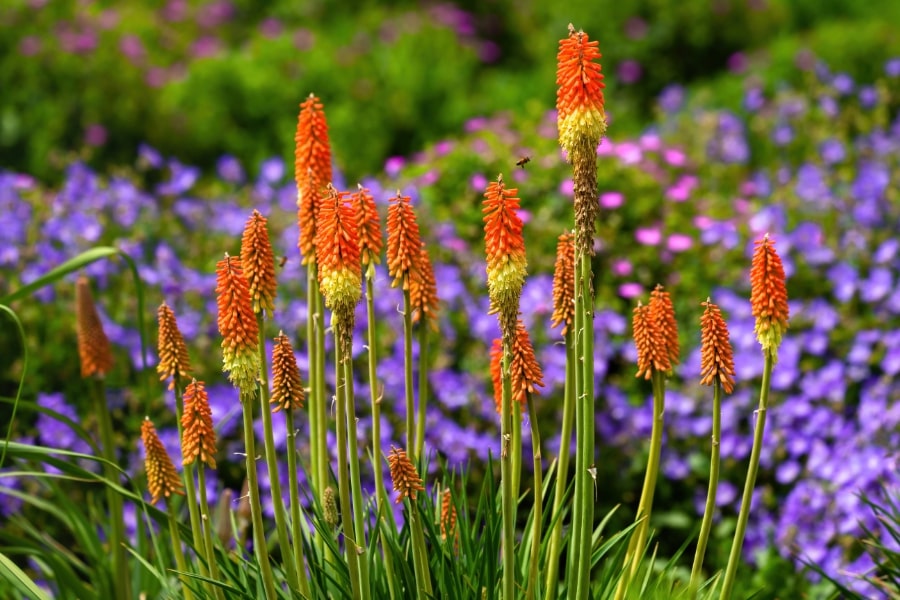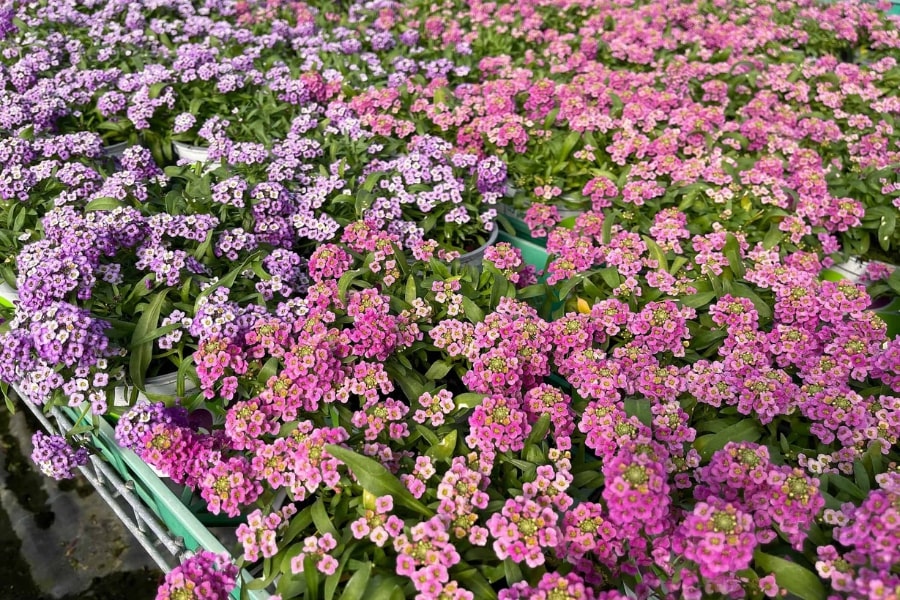Martin Garden Center boasts the largest selection of flowering plants in the Upstate. We carry hundreds of perennials from Agastache (Hyssop) to Yarrow (Achillea) in 4″ pots, and some grow so large that we shift them up to 6″ pots & 1-gallon pots. The most popular perennials we carry at Martin Garden Center include Coreopsis (Tickseed), Echinacea (Coneflower), Euphorbia, Phlox (Thrift), Rudbeckia (Black Eyed Susan), Salvia (Sage), and Sedum Lemon Ball.

Perennials are seasonal. For example, early blooming plants such as Iberis (Candytuft), Poppy, and Columbine tend to be available in the early Spring but not during the Summer and fall. Late-blooming plants such as Asclepias (Butterfly Weed) and Coneflower (Echinacea) tend to be available in late Summer/early Fall.
6″ and Gallon Perennials
We also carry perennials that are larger sizes and are planted immediately in 6″ or 1-gallon pots, and sometimes in 2-gallon or 3-gallon pots. Some perennials establish root systems quickly, or grow and spread quickly and thus are not well suited to the confines of a 4″ container. Many of these larger perennials also offer instant impact, providing fuller foliage and, in some cases, blooms at the time of planting. We carry over fifty 6″ and Gallon Perennials, which are referenced on their own page: Gallon Perennials.
![]()
The list of 4″ perennials that we carry includes, but is not limited to, the following Full Sun and Part Sun Plants:
Full Sun Perennials
Full sun in the Upstate is considered more than 4 hours of afternoon sun. Or, more than 6 hours of morning and afternoon sun.
- Achillea (Yarrow)
- Agastache (Hyssop)
- Asclepias (Butterfly and Milk Weed)
- Aster
- Blue Star Creeper (Isotoma Fluviatilis)
- Cardinal Flower (Lobelia cardinalis)
- Coreopsis (Tickseed)
- Delosperma (Ice Plant)
- Delphinium (Larkspur)
- Dianthus (Pinks)
- Echinacea (Coneflower)
- Erysimum (Wallflower)
- Euphorbia (Spurge)
- Foxglove
- Gaillardia (Blanket Flower)
- Gaura
- Gazania
- Helenium (Sneezewood)
- Hens & Chicks
- Iberis (Candytuft)
- Kniphofia (Red Hot Poker)
- Lambs Ears (Stachys)
- Leucanthemum (Shasta Daisy)
- Lithodora
- Lysimachia (Creeping Jenny)
- Mazus
- Monarda (Bee Balm)
- Muehlenbeckia (Wire Vine)
- Nepeta (Catmint)
- Oenothera (Evening Primrose)
- Penstemon (Beardtongue)
- Phlox (Thrift)
- Poppy
- Plumbago
- Rudbeckia (Black Eyed Susan)
- Rumex (Red Vein Dock)
- Salvia (Sage)
- Scabiosa (Pincushion Flower)
- Setcreasea (Purple Heart)
- Sedum (Stonecrop)
- Speedwell (Veronica)
- Verbena
- White Star Creeper

Part Sun to Shade Perennials 4″
Part Sun Perennials prefer less than 4 hours afternoon sun or exclusively morning sun with afternoon shade.
- Ajuga
- Aquilegia (Columbine)
- Anemone (see Gallon Perennials)
- Balloon Flower (Platycodon)
- Campanula (see Gallon Perennials)
- Lobularia (Sweet Alyssum)
- Ivy
- Lamium (Dead Nettle)
- Sagina (Moss)
- Strawberry Begonia
- Sweet Woodruff
- Vinca Vine

More about Perennials
One of the main uses of Perennials is their ability to provide year-round interest in the garden. While some Perennials may only bloom for a few weeks each year, others can provide interest year-round through their foliage, texture, or architectural form. Many perennials also have a long blooming period, allowing gardeners to enjoy their flowers for weeks or even months at a time. With the proper selection of perennials, it is possible to create a beautiful and exciting garden throughout the growing season without the need for constant replanting and maintenance. Also, be sure to check out our guide covering Common Pests.
Another advantage of perennials is their ability to adapt to a wide range of growing conditions. While some perennials may prefer full sun, others can thrive in partial shade or even full shade. Similarly, some perennials may prefer dry, well-draining soil, while others can tolerate wet or boggy conditions. This versatility makes perennials an ideal choice for gardeners who are dealing with challenging growing conditions, or who are looking to create a garden with a range of microclimates.
Some perennials are renowned for the ability to attract pollinators, butterflies and hummingbirds. One of the best pollinators we’ve found at Martin Garden Center is Agastache (Hyssop) Blue Boa. Also, Hot Lips Salvia is another exemplary pollinator as well as a hummingbird attractor. Butterfly Weed (Asclepias tuberosa) is the main source of food for the Monarch Butterfly.
